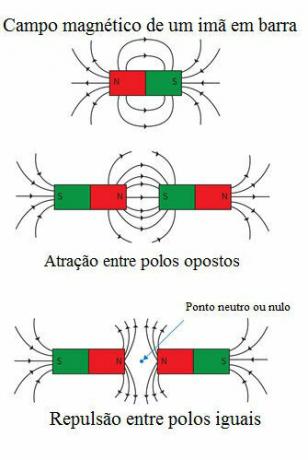One magnet it is a body that generates magnetic field around you. It can be classified in two ways:
Natural: when it comes to iron oxide, a mineral found in nature that is called magnetite;
Artificial: when it is built with metallic alloys (or ceramic materials) which, when subjected to strong magnetic fields, acquire magnetic properties;
The first observations relating to magnetism were recorded in Ancient Greece, in a city called Magnesia where a mineral was found that had the ability to attract small objects from iron. This material came to be known as magnetite because of the name of the place where it was found. The name of this city also gave rise to the term magnetism.
However, studies in this area were only deepened in the 1600s by the English physicist William Gilbert (1554 – 1603). Among his discoveries, the existence of the Earth's magnetic field and the properties of magnets stand out.
Properties of magnets
We can highlight five properties that characterize a magnet, are they:
Ability to attract other objects, specifically some metals such as iron;
The regions where the magnetic fields are strongest in a magnet are called magnetic poles. These are classified as north (positive) and south (negative);
When approaching the magnetic poles of two magnets, we can verify two situations: repulsion, if the approximate poles are equal; or attraction, if they are different poles. Note in the figure:

When bringing two magnets together, the poles with the same signs repel each other, while the poles with the opposite signs attract each other.
-
alignment with the geographic poles of the Earth, which occurs if a magnet is positioned in such a way that it can move freely. The orientation of the magnet is as follows: the north pole of the magnet points towards the geographic north of the Earth, and the south pole is oriented towards the geographic south pole of the Earth. This phenomenon is possible due to the existence of the Earth's magnetic field.
Do not stop now... There's more after the advertising ;)
Inseparability of the magnetic poles, that is, there cannot be a magnet with only a south pole or a north pole. This means that if a magnet is broken, a new magnet will form. The reason for this phenomenon is the fact that magnetism is a property that has its origin in the organization molecular substance, so even the smallest molecule in a magnet has both poles well. defined.
Earth's magnetic field
The Earth also behaves like a large magnet, having well-defined magnetic poles. The Earth's geographic north pole is magnetic south, and the geographic south is magnetic north. Thanks to these magnetic properties of the Earth, we can orient ourselves using the compass.
The compass, which is formed by a needle made of magnetite supported on a small support, can rotate freely and orient itself according to the Earth's magnetic field. However, the compass does not point exactly to the Earth's geographic poles, since the poles The magnetic poles do not exactly coincide with the geographic poles, as they are out of phase approximately 11.5° a from the other.

The figure shows the Earth's magnetic field lines and that the magnetic and geographic poles are 11.5° apart.
By Mariane Mendes
Graduated in Physics
Would you like to reference this text in a school or academic work? Look:
TEIXEIRA, Mariane Mendes. "What is a magnet?"; Brazil School. Available in: https://brasilescola.uol.com.br/o-que-e/fisica/o-que-e-ima.htm. Accessed on June 27, 2021.

